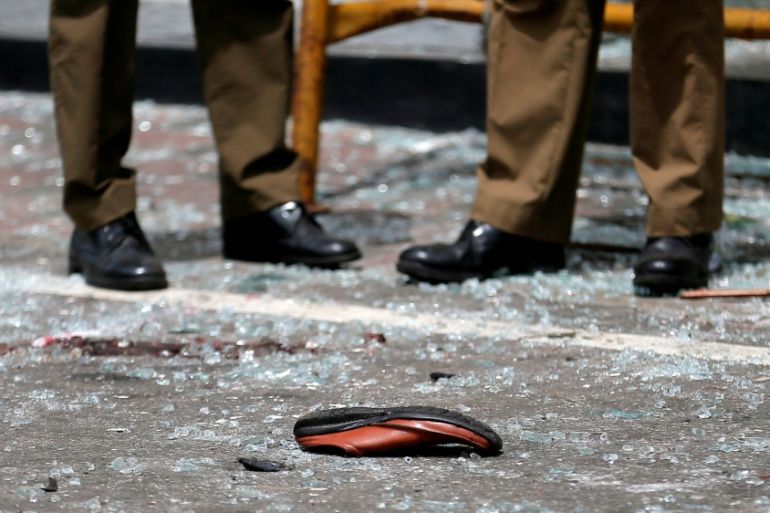‘Just their shoes’: Sri Lanka struggles to identify the dead
Hospital staff, families face up to trauma of distinguishing disfigured bodies in wake of deadly Easter Sunday blasts.

Colombo, Sri Lanka – In a courtyard outside the mortuary, a doctor dressed in scrubs, white boots and a hairnet sat at a table in front of a laptop. Around him, family members stared at the screen as he scrolled through a gory tableau of blood-stained faces, mangled limbs and twisted bodies.
The process of identifying the dead from Sri Lanka‘s worst attacks in decades begins and ends here – the mortuary of Colombo’s National Hospital.
Keep reading
list of 4 itemsSri Lanka to probe allegation of intelligence complicity in 2019 bombings
Protest in Sri Lanka on fourth anniversary of Easter bombings
Sri Lanka ex-leader ordered to compensate Easter bombing victims
“It’s very difficult to identify the bodies,” Father Shelton Dias of the Archdiocese of Colombo told Al Jazeera. “They are so disfigured. With some of the children it’s just their shoes. That’s all. Terrorism has no mercy.”
A day after a series of deadly bombings in Sri Lanka’s capital, Colombo, and two other cities, Sri Lankans are struggling to come to terms with the tragedy. The attacks killed nearly 300 people and wounded hundreds more, prompting the government to deploy the military, shut down social media, and declare a state of emergency.
|
|
At the morgue, MN Jenson and his mother were among the families waiting to look at the images of the dead. His grandfather, Sebamalai Pichchai Liner, had been celebrating Eastern Mass at St Anthony’s Shrine in central Colombo, and was now missing.
Desperate for news as the death toll rose, Jenson and his mother called Liner’s mobile phone again and again, but when the phone was turned off they started to make the rounds of the city’s five government hospitals.
After their third trip to the National Hospital, the biggest in Sri Lanka with 3,500 beds, and with no sign that his grandfather had been admitted to a ward or been formally identified, they headed to the morgue on Monday.
Moments after looking at the screen, Jenson stepped outside, steadying himself against the wall. Tears welled in his eyes. He grasped at his beard and held his head in his hands.
He could barely speak.
Together, he and his mother must steel themselves for the formal identification of the body the final step before they would be allowed to bring their grandfather home for burial.
![The first blast was reported at St Anthony's Shrine, an historic Roman Catholic church in Colombo [Ishara S Kodikara/AFP]](/wp-content/uploads/2019/04/3ffb80e6e3b94a55930d9e3b0613c0a5_18.jpeg)
Tuan Yoonus, 85, and his family, were just leaving the morgue where they found the body of their relative, Arshad Yaheya.
Arshad, who had been an employee at the Cinnamon Grand, was enjoying a complimentary stay at the hotel to celebrate his 36th birthday when the bomb ripped through the restaurant where he and his family were having breakfast. Arshad was killed while his wife and two daughters were wounded.
Yoonus pushed up his glasses and struggled to hold back tears as he read the hotel’s tribute to his nephew on a mobile phone.
“We want to bury him today,” said Yoonus, whose family is Muslim. “We need to do it within 24 hours. That’s our religion.”
‘Nothing like this’
The Catholic Church has been using its network to help identify the missing and the dead. Dias told Al Jazeera he visited the intensive care units of Colombo’s government hospitals on Monday to gather information on the patients to help district and parish priests locate family members.
Pushpa De Soysa, a nurse who manages the triage department at the National Hospital, said some 267 people were brought to the hospital as the tragedy unfolded on Sunday.
Fifty-one were already dead, De Soysa who has been a nurse for 25 years, told Al Jazeera.
“Over the last three decades we’ve faced many disasters,” she said. “But we have never had anything like this.”
On Monday, 118 people were still in the National Hospital, including 25 in intensive care and six children under the age of 12. Some had been transferred from other hospitals in the capital.
“It’s manageable,” De Soysa said, noting the hospital had been inundated with donations of water and other necessities since the attacks.
Tight security
Outside, Colombo’s usually bustling streets remained largely empty with schools closed and shops shuttered. Security was tight at major government offices, landmarks and hotels across the city, while police, armed soldiers and sniffer-dog teams patrolled the streets.
At St Anthony’s Shrine, white streamers hung across the streets in remembrance of the dead, but residents remained on edge.
A controlled explosion at about 4pm of a device that had been found in a van parked on the street triggered panic on the streets as people rushed to safety. The discovery of what was suspected to be a second explosive device an hour only added to the unease.
The Catholic Church, meanwhile, is providing money and support to those needing to organise funerals, from preparing the body to providing a coffin and a suitable location for a wake, particularly when entire families were killed.
“People came as a family to church, especially to Sunday Mass,” Dias said. “They sat as a family. They died as a family.”
![Three churches were targeted in Sunday's attacks [File: AP]](/wp-content/uploads/2019/04/b6a7cd9ad3944093b640d09aa3b8e8e7_18.jpeg)